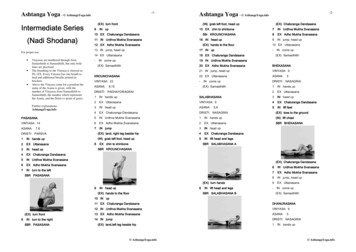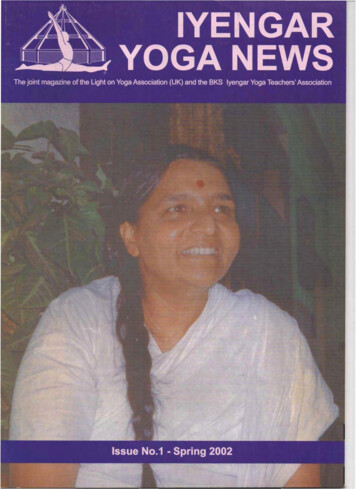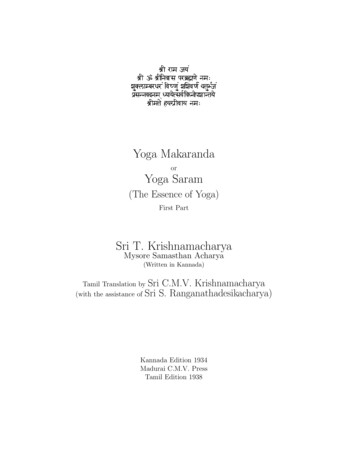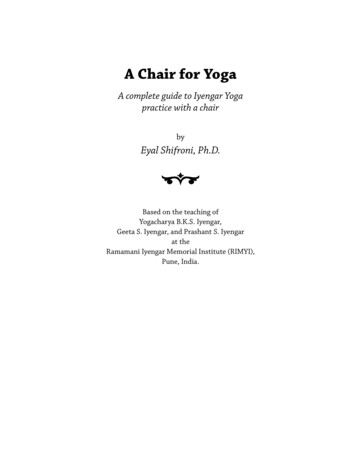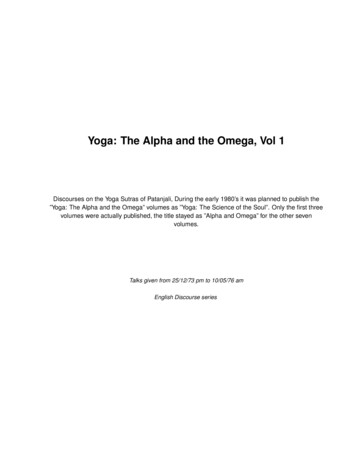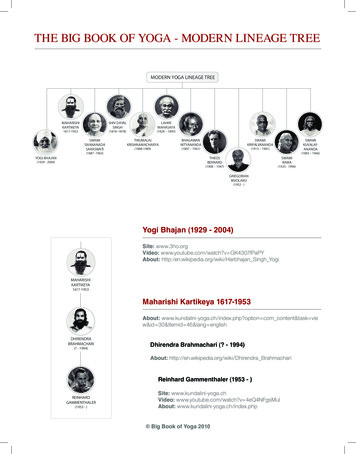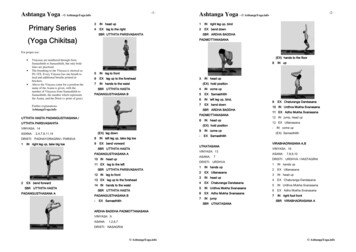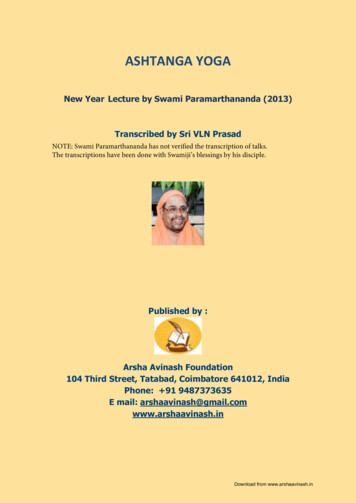
Transcription
ASHTANGA YOGANew Year Lecture by Swami Paramarthananda (2013)Transcribed by Sri VLN PrasadNOTE: Swami Paramarthananda has not verified the transcription of talks.The transcriptions have been done with Swamiji’s blessings by his disciple.Published by :Arsha Avinash Foundation104 Third Street, Tatabad, Coimbatore 641012, IndiaPhone: 91 9487373635E mail: arshaavinash@gmail.comwww.arshaavinash.inDownload from www.arshaavinash.in
General TalksAshtānga YōgaAshtānga Yōgasadāsiva samārambhām sankarāchārya madhyamāmasmad āchārya paryantām vande guru paramparāmFirst of all, I wish all of you a very happy, healthy and prosperous NewYear 2013. Last year, I talked about the popular word Yōga and howdifferent meanings are there for the word Yōgaha. In the Vēdicscriptures, I said that the primary meaning of the word Yōga is theAykyam or oneness between Jīvātma and Paramātma.According to the scriptures, Jīvātma and Paramātma are always one.Because of ignorance, we have created a division between Jīvātma andParamātma. When we remove this notional division through knowledge,it is called Jīvātma Paramātma Aykyam, which is nothing but Gnyānam.Therefore, the primary meaning of the word Yōga is Gnyānam, which isin the form Jīvātma Paramātma Aykyam.This is the ultimate goal of every Jīva. Therefore, we call it SādhyaYōgaha, Yōga the destination. To reach this destination, the scripturespresent several spiritual disciplines. All those disciplines are also calledYōgaha. All these Yōgās are generally called Sādhana Yōga becausethey serve as a means to attain the Sādhya Yōga of Gnyānam andAykyam.Varieties of Sādhana Yōgās are talked about. We have seen one type ofSādhana Yōga called Karma Yōga which will take us to the destination.The second type of Sādhana Yōga is Upāsana Yōga which also willhelp. The third type of Sādhana Yōga is Gnyāna Yōga which isconsistent and systematic study of Spiritual scriptures like the Gīta, forlength of time, under the guidance of a competent guide, Ācharya.This Gnyāna Yōga also will come under Sādhana Yōga. Thus, KarmaYōga, Upāsana Yōga, Gnyāna Yōga are all Sādhana Yōgās. TheGnyānam, the spiritual knowledge that is attained by following them isDownload from www.arshaavinash.inPage 1 of 15
General TalksAshtānga Yōgacalled Sādhya Yōgaha which is in the form of Jīvātma ParamātmaAykyam which is Mōkshaha.Along with these three Sādhana Yōgāha, we add one more Yōgaha.That is called Ashtānga Yōgaha which is also considered a veryimportant Sādhana Yōgaha. Today, I would like to briefly dwell on thistopic of Ashtānga Yōgaha, which is otherwise called Pātanjala Yōgaha.It is spiritual discipline which is propounded by Patanjali Maharshi.Therefore, it is called Pātanjala Yōgaha. Patanjalaha means propoundedby Patanjali Maharshi. This Ashtānga Yōga has been presented byPatanjali Rishi in his well known work called Yōga Sūtrāni. Patanjali’sYōga Sūtrās are very popular. Now, Ashtānga Yōgaha has become morepopular than all other Yōgās. These Yōga Sūtrās have got two parts.One is a philosophy which is presented by Patanjali which is calledYōga Darshanam. The second part is a scheme of spiritual disciplinewhich is also presented in the Yōga Sūtrās. This scheme of discipline iscalled Yōga Sādhana. Yōga Darshanam is philosophy, Yōga Sādhana isspiritual discipline. Of these two, generally we don’t take YōgaDarshanam in the tradition.The tradition does not take the Yōga Darshanam or philosophy becauseit deviates from the Vēdic teaching. Therefore, the Darshanam part isrejected. In the famous Brahma Sūtra of Vyāsāchārya, while presentingthe Vēdic vision, Vyāsāchārya sets aside the Yōga Darshanampropounded by Patanjali Maharshi. Therefore, for Darshanam, we don’tfollow Yōga Darshanam, but we follow Vēdānta Darshanam.Even though we reject the Yōga Darshanam part of Yōga Sūtrās, weaccept the other part. What is the other part? Yōga Sādhana which iscalled Ashtānga Yōgaha, which is a fantastic discipline accepted byVyāsāchārya and accepted by Shankarāchārya. While accepting theAshtānga Yōga, we make certain modifications in its interpretation sothat it is in agreement with Vēdānta Darshanam.Download from www.arshaavinash.inPage 2 of 15
General TalksAshtānga YōgaThus, Yōga Sādhana is reinterpreted, redesigned and adapted to beVēdāntic teaching. This Ashtānga Yōga, being very beautiful and veryuseful for all the people, I propose to briefly present its principles.While defining Yōga in the Yōga Sūtrās, Patanjali Maharshi presentsthe definition.In this particular context, he gives the definition of Yōga as ChittaVrutti Nirōdhaha. Chittam means Mind, Vrutti means function.Literally, it means thought or Vrutti or Pravrutti. Pravrutti meansfunction. Chitta Vrutti means mental function. Nirōdhaha meansdisciplining or regulating.Therefore, Ashtānga Yōga is a scheme for regulating or disciplining themental function. In simple language, Yōga means mental discipline.Mental discipline is extremely important for all people. We will knowthe importance of this mental discipline (Yōga) if we know two thingsregarding the mind.We should know the greatness of the mind, which we are blessed withas a powerful internal organ. Mind is a very important and powerfulinternal organ. We should know the greatness of the mind. We alsoshould recognize the problem faced by the mind. If we understand thegreatness of the mind and also understand problem of the mind, we willknow the importance of Ashtānga Yōga.What is the greatness of the mind? It is the most powerful instrumentthat we have, with which we can accomplish all the goals of life likeDharma, Artha, Kāma and Mōksha. We have got a powerful instrumentfor accomplishing all the goals, which is the mind. The mind is aprominent instrument also because it has to be utilized in all ouractivities.We have got different sense organs for different activities. For seeingform and colors, eyes are used. When you want to hear something, wedon’t use the eyes, but we use the ears. As far as sense organs areDownload from www.arshaavinash.inPage 3 of 15
General TalksAshtānga Yōgaconcerned, they are used only in particular areas, but not always. As faras mind is concerned, it has to be employed in all the areas.Therefore, mind is a primary instrument, in addition to being a powerfulinstrument. Mind is not only primary and powerful, but it has got aunique capacity to convert heaven into hell and to convert hell intoheaven. A person with all wonderful things can feel miserable and aperson surrounded by all negative things can fell wonderful also.Mind has the capacity to convert heaven into hell and hell into heaven.That means the quality of our life is determined by the most important,most powerful instrument called Mind - mana ēva manushyānāmkāranam bandha mōkshayōh. These are all the glories of the mind. Youcan do an Ashtōttara Archana.In fact, we do that in the Shāstra. It is called Hiranyagarbha Upāsanam.It is nothing but glorification of the mind. saya eshōntar hrudayaākāshaha, tasminayam purushō manōmayaha - ManōmayaHiranyagarbha Upāsana. This is the positive side of the mind, butequally, the mind has got a very serious problem also.What is the serious problem of the mind? The mind has the nature ofgenerating continuous thoughts. Mind has the nature of generatingcontinuous thoughts without taking permission from us, without ourparticipation, without our will, without our involvement, even though itis supposed to be our instrument.Therefore, the mind is supposed to do everything after askingpermission from the owner. Who is supposed to be the owner? I amsupposed to be the owner and the mind is supposed to generate thoughtswith my permission. Unfortunately, the mind has got a nature ofgenerating continuous, involuntary thoughts. Even now, it is happening.I have no idea that what all involuntary thoughts are going in which allminds and I don’t know who is listening to me. This generation ofDownload from www.arshaavinash.inPage 4 of 15
General TalksAshtānga Yōgacontinuous, involuntary thoughts is a very serious problem. Because ofthat, several adverse consequences take place. The first adverseconsequence is - when the mind generates involuntary thoughts, themind is under the grip of the involuntary thoughts that the involuntarythoughts kidnap the mind.The involuntary thoughts kidnap the mind, which means the mind is notavailable for my use. Even though Bhagawān has given me a wonderfulmind, I am deprived of the benefit. It is like I buy a car for my use andall the family members take it for all their purposes. I want to come tothe morning class and the car is not available.Imagine, I buy an instrument and it is not available. Bhagawān hasprovided the most glorious instrument called the mind and involuntarythoughts encroach upon it. There is powerful property dispute which weare not aware of. What is the property dispute? We are not even awarewho the owner of the mind is.Who is the winner in this dispute, most of the time? It is like ourproperty or Government property is encroached and a seven-storedbuilding is constructed. Government recognizes after 15 years anddemolishes. Thus, involuntary thoughts are the encroachers whichkidnap the mind and the biggest problem is that I don’t have mind formy use, most of the time.My mind is pre-occupied and I do almost all actions as an absentminded person, as a mind-less person. Somebody called it - living inabsentia. I go through the entire life in absentia because the mind is notavailable. Because of this absentmindedness, the consequences are - as aKarta, I am inefficient in all my actions.Many mistakes are committed. Forgetfulness is a problem. I misplacethings all over and most of the time, I waste hours for searching thethings I myself have kept absent mindedly. Almost everything I have tosearch. As a Karta, I am prone to blunders. As a Bhōkta, I cannot enjoyDownload from www.arshaavinash.inPage 5 of 15
General TalksAshtānga Yōgaa beautiful music program because I am in the auditorium, but my mindis somewhere else.As I often say - I am here, but I don’t hear (absent minded). Therefore, Ifail as a Karta and I fail as a Bhōkta. As Pramāta, a learner, I cannotlearn anything because I don’t listen as the mind is not there behind theears. I lack listening skill. Several communication gaps are causedbecause of that.I announce the program in the morning and invariably, some studentscome in the evening and call me. The announcements are not registered.Every time an announcement comes, some people recall and ask. So,involuntary thoughts are the greatest enemy that we have notrecognized.The second problem is - when the involuntary thoughts are movingconstantly in the mind, several times they generate disturbing emotionsalso. During the course of these involuntary thoughts, withoutpermission, these involuntary thoughts generate several disturbing, toxicemotions like worry, anxiety, fear, depression, regret, hurt, guilt etc.All the disturbing emotions are generated in the mind by the involuntarythoughts. Without my invitation, they come and encroach upon mymind. Not only that, but often when I ask them to go, they don’t goaway. Therefore, the second problem is emotional disturbances. Whenthey remain for a long time, I lose my health.Involuntary thoughts remove my efficiency. Loss of efficiency is oneadverse consequence. Loss of health is the second adverse consequencebecause of toxic emotions. In fact, many of the modern diseases arecaused by stressful mind.Stress means involuntary thoughts are continuously running in my mindvery, very fast. The third and more serious problem is - when I grow oldand when I retire and withdraw from most of the activities, as I cannotDownload from www.arshaavinash.inPage 6 of 15
General TalksAshtānga Yōgado them, I am stuck with my body and mind. In the old age, I have amind which I don’t own. I am stuck with the mind. I can send away anyother thing, but I cannot send away the mind.Wherever I go, I am stuck with a mind which I don’t own, but owned byinvoluntary thoughts. Therefore, thoughts after thoughts come and mindis tortured by all types of problems. I call them FEDEREL problem problem of old age. FE means Fear, DE means Depression, RE meansRegrets and L means Loneliness.I am stuck with a mind which is gripped with FEDEREL problem. Andthe old age becomes the most miserable thing. All this is because of thefact that I did not recognize the problem of involuntary thoughts and thedisastrous consequences of not tackling these involuntary thoughts.Ashtānga Yōga is a scheme by which I learn to be aware of this problemand take steps to handle this problem.Ashtānga Yōga, as the very word shows, consists of eight steps knownas Yama, Niyama, Āsana, Prānāyāma, Pratyāhāra, Dhārana, Gnyāna,and Samādhi. These are the eight steps of Ashtānga Yōga. Of these, thefirst two Yama and Niyama are general disciplines. I will brieflymention them later.Today, I would like to focus on the later six parts Shadanga Yōgahacalled Yōgic meditation which is an exercise to make myself aware ofthis problem. Only when I am aware of this problem, I will be serious intackling the problem. What is this Shadanga Yōgābhyāsa? I want to seewhether involuntary thoughts are powerful, occupying my mind orwhether I am the owner of the mind, capable of giving a job to mind.Who is the boss? Is the involuntary thought the boss or am I the boss?What are these Shadanga Yōga? The first step is Āsanam, in which I amsupposed to be seated in a posture deliberately. I should consciouslytake up a physical posture and become intensely and totally aware of myentire body, top to bottom.Download from www.arshaavinash.inPage 7 of 15
General TalksAshtānga YōgaI am conscious of the body, conscious of the posture and I consciouslyrelax the body. If I can consciously do that, it means that I have got mymind available for my job. Incidentally, it will help in relaxing also.This is called the Āsanam - cons
ASHTANGA YOGA New Year Lecture by Swami Paramarthananda (2013) Transcribed by Sri VLN Prasad Published by : Arsha Avinash Foundation 104 Third Street, Tatabad, Coimbatore 641012, India Phone: 91 9487373635 E mail: arshaavinash@gmail.com www.arshaavinash.in NOTE: Swami Paramarthananda has not verified the transcription of talks. The transcriptions have been done with

